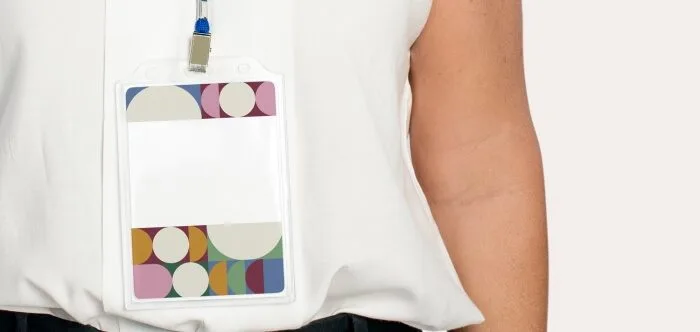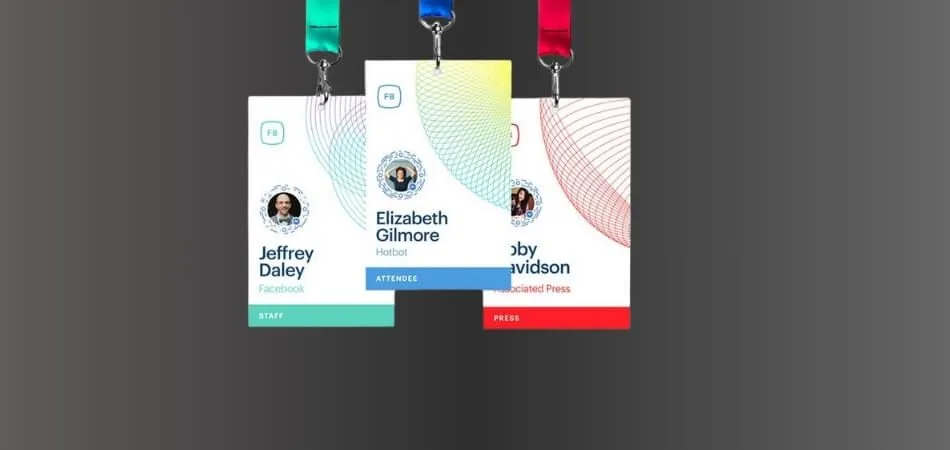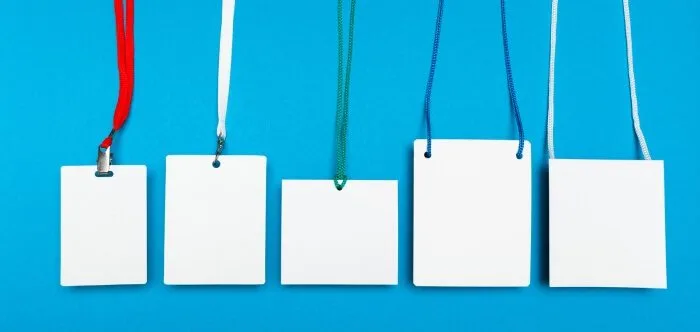Conference badges are more than just pieces of paper or plastic; they’re a key element of any event, serving as a visual representation of your identity and affiliation. But how do you make a conference badge that stands out and effectively conveys information?
To craft a conference badge, you’ll need to design a template that incorporates attendee details, event logos, and pertinent information. Once your design is ready, you’ll print it on sturdy paper or plastic. Don’t forget the final touches, such as cutting out the badge and attaching a lanyard or clip for easy wear.
Curious to learn more about the art of crafting conference badges that leave a lasting impression? Keep reading this article to discover helpful tips, creative ideas, and step-by-step instructions to ensure your event badges shine.
Conference Badge – What Does it Signify?
A conference badge is much more than just a piece of paper or plastic you wear around your neck at an event. It’s a powerful symbol that signifies your identity and connection to the conference community. These badges help attendees easily recognize each other, fostering networking and collaboration.
Each conference badge typically includes your name, job title, and organization, offering a quick snapshot of who you are and where you’re from. It’s like your mini-billboard, allowing others to strike up meaningful conversations based on shared interests or backgrounds. One of the key elements of conference badges is how they display crucial details that make it easier for attendees to connect.
Moreover, conference badges often display the event’s logo and theme, reinforcing a sense of belonging to the gathering. They can even serve as mementos, reminding you of the knowledge gained, connections made, and experiences enjoyed at the conference. In essence, a conference badge is your entry ticket to a world of learning, sharing, and connecting with like-minded individuals.
Different Types of Conference Badge
Conference badges come in various forms, suited to different needs and preferences. Understanding the types of conference badges can help event organizers choose the best fit for their attendees. Here are the common types of conference badges:
Paper Badges
These are the traditional choices, often cost-effective and easy to customize. Paper badges can be printed in bulk, making them suitable for large events. However, they may not be as durable as other options, so they are best for shorter conferences or events with limited budget constraints.
Plastic Badges
Plastic badges are a popular choice for a more durable and professional look. They can withstand wear and tear, making them suitable for multi-day conferences. They also offer a higher level of customization and can include features like holographic elements for added security.
Reusable Badges
Environmentally conscious events often opt for reusable badges. These badges have a detachable or erasable section for personalization, allowing them to be used for multiple events. They are not only eco-friendly but also cost-effective in the long run.
QR Code Badges
With the rise of technology, QR code badges are gaining popularity. Attendees can scan these badges for easy access to event materials, schedules, and contact information. They streamline the check-in process and provide a digital connection to event resources.
Digital Badges
These badges exist purely in the digital realm and are accessible through mobile apps or email. They’re convenient for contactless check-ins and reduce paper waste. Digital badges also offer the advantage of being easily shareable on social media and professional networking platforms.
Essentials You’ll Need to Make a Conference Badge
Designing and crafting conference badges requires a set of essential tools and materials to ensure they are both visually appealing and functional. Here’s a more detailed look at what you’ll need:
- Badge Design Software: To create eye-catching badges, you’ll need graphic design software like Adobe Illustrator or Canva. These tools allow you to customize badge templates with attendee information, logos, and event details.
- Printer: Invest in a high-quality printer, preferably a color printer, capable of producing sharp and vibrant prints. This is crucial for badges that look professional and are easy to read.
- Sturdy Badge Paper/Plastic: Choose the right material for your badges. Sturdy options like heavy paper or plastic sheets are ideal, as they resist wear and tear, ensuring badges remain intact throughout the event.
- Cutting Tools: Precision is key when cutting badges. Ensure clean edges by using sharp scissors, keeping in mind standard conference badge dimensions for a consistent and professional appearance across all badges.
- Lanyards or Clips: To make badges wearable, provide lanyards or clips. These accessories allow attendees to comfortably display their badges throughout the event, making it easier for others to identify them.
- Optional Extras: Consider additional elements for enhanced functionality or security. Badge holders protect badges from damage, QR codes provide quick access to event materials, and holographic features can deter counterfeiting.
By using these essential tools and materials, you can create conference badges that not only look professional but also serve their intended purpose effectively.
How Do You Make a Conference Badge?
Creating an effective conference badge involves a series of steps to ensure they are not only informative but also professionally presented. Here’s a detailed step-by-step process on how do you make a conference badge:
Step-1. Design Your Badge Template
Begin by designing a template using graphic design software like Adobe Illustrator or Canva. Include attendee names, job titles, organizations, event logos, and any other pertinent information. A well-thought-out design sets the tone for your badges.
Step-2. Choose the Right Material
Select a suitable material for your badges, such as heavy paper or durable plastic sheets. The choice depends on the event’s duration and expected wear and tear. Sturdy materials ensure your badges hold up throughout the conference.
Step-3. Print Your Badges
Use a high-quality printer, preferably a color printer, to ensure your badge designs come out sharp and clear. Print a few test badges to verify the quality before producing the entire batch. Consider the quantity needed, and make sure to have spare materials on hand in case of unexpected printing issues.
Step-4. Cut Out the Badges
Precision is key when cutting out badges. Use sharp scissors or a paper cutter to ensure clean, straight edges. Neatly trimmed badges contribute to a professional appearance. Take your time during this step to avoid any accidental damage to the badges.
Step-5. Add Optional Features
Depending on your event’s requirements, consider adding extra features to your badges. Badge holders protect them from damage, QR codes provide quick access to event materials, and holographic elements can enhance security.
Step-6. Attach Lanyards or Clips
To make badges wearable, provide lanyards or clips that are not only comfortable but also user-friendly. Opt for lanyards with safety breakaways to prevent accidents. Ensure that badges are easy to display and don’t flip around during the event.
Step-7. Organize Distribution
Plan the distribution process efficiently, whether it’s during registration or at a designated badge pickup area. Verify attendee information to prevent errors and ensure a seamless check-in process. Consider organizing badges alphabetically or by registration type to accelerate distribution.
By following these comprehensive steps, you’ll create conference badges that not only convey essential information but also contribute to the overall professionalism and success of your event, leaving attendees with a positive impression.
Making a Conference Badge – Is it Worthwhile?
Yes, making a conference badge is worthwhile. A well-designed badge enhances the attendee experience and contributes to the event’s organization. It’s not just a simple name tag; it plays a crucial role in networking and event management.
Cost-Effectiveness
Creating badges can be cost-effective, especially when done in bulk. However, the quality of materials impacts the overall cost. For smaller events, making free conference badges might be an appealing option. Consider balancing budget constraints with the need for durability and professionalism.
Customization Options
Customization adds value by allowing badges to reflect the event’s theme and branding. Attendees appreciate personalized details, such as their names and roles. This can make the badge more meaningful and memorable. It also helps create a sense of belonging and connection.
Professional Presentation
A well-designed badge presents a professional image, enhancing the overall event experience. It shows that organizers care about the details. Clean, polished badges reflect the event’s quality and importance. This small touch can leave a lasting impression on attendees.
Functionality and Utility
Conference badges are functional tools that serve more than just identification purposes. They grant access to various sessions and areas. Including important details like event schedules can increase their utility. This multifunctional aspect makes them indispensable at conferences.
Security Considerations
Badges play a crucial role in maintaining event security by controlling access. They help identify authorized attendees, keeping uninvited guests out. Using different designs for various access levels can enhance security. This approach ensures that the right people are in the right places.
Making a conference badge is indeed worthwhile due to its multifaceted benefits. From cost-effectiveness to security, badges contribute significantly to the overall success of an event. Thoughtfully designed and executed badges can elevate the experience for both attendees and organizers.
Common Barriers to Avoid While Making a Conference Badge
Making conference badges is essential for event success, but certain pitfalls can block their effectiveness. Here are common barriers to avoid, along with some additional insights:
- Inadequate Design: Poorly designed badges with cluttered or unclear information can confuse attendees. Opt for a clean, well-structured design that prioritizes essential attendee details.
- Low-Quality Printing: Printing badges with low-resolution graphics or subpar quality can lead to illegible text. Invest in a high-quality printer to ensure sharp and professional-looking badges.
- Lack of Durability: Using flimsy materials makes badges prone to damage. Choose sturdy materials like heavy paper or plastic sheets to ensure badges hold up throughout the event.
- Complex Distribution: Poorly organized distribution processes can cause delays and frustration among attendees during check-in. Plan an efficient badge pickup or registration process to streamline the attendee experience.
- Overlooked Security: Neglecting security features may make badges susceptible to counterfeiting. Consider adding holographic elements, barcodes, or other security measures to protect against unauthorized access.
- Uncomfortable Attachments: Choosing uncomfortable or difficult-to-use lanyards or clips can result in attendee discomfort. Select user-friendly and comfortable attachment options to ensure badges are easy to wear.
By avoiding these common barriers and incorporating these insights, you can ensure that your conference badges serve their intended purpose effectively and enhance the overall attendee experience, contributing to a successful event.
FAQs about How Do You Make a Conference Badge?
In order to create a successful conference badge, careful planning, design, and attention to detail are essential. The goal isn’t just to print names; it’s to create a tool that enhances the event experience. A list of frequently asked questions about conference badges is provided below.
What Materials Do You Need to Make a Conference Badge?
You need durable paper or cardstock, a printer, and protective coverings like laminates. Additionally, you’ll need lanyards or clips to attach the badge, ensuring it’s both practical and professional.
What Information Should Be Included on a Conference Badge?
A conference badge should include the attendee’s name, job title, and organization. You may also add the event logo and, if applicable, access levels or roles to help with identification and networking.
How Do You Design an Effective Conference Badge?
Use a simple, clean layout with clear fonts and adequate spacing. Include the event’s branding, and ensure that key details like names are prominent. The design should be both functional and visually appealing, enhancing the event’s professional image.
Can You Make Conference Badges on a Budget?
Yes, making conference badges on a budget is possible by using affordable materials and printing options. Opt for making free conference badges by utilizing templates or online tools, and consider bulk printing to reduce costs while maintaining quality.
How Do You Ensure the Badges Are Durable?
To ensure durability, use high-quality materials like thick cardstock and laminate the badges. Laminating or using badge holders will protect them from wear and tear, keeping them in good condition throughout the event.
What are Some Tips for Cutting Conference Badges?
Use sharp scissors or a paper cutter for precise, clean edges. Consistent sizing is important, so consider measuring each badge to maintain uniformity. Proper cutting enhances the badge’s overall appearance, making it look polished and professional.
Bottom Line
The art of crafting a conference badge extends beyond mere paper or plastic; it represents a powerful symbol of identity and connection within the event community. If you wish to know how do you make a conference badge, it may seem like a straightforward process. Still, the process involves careful planning, from design and material selection to printing and distribution.
These badges contribute significantly to the event’s professionalism and security, provide networking chances, and give access to vital information. Organizations can customize their selections to meet the unique requirements of their attendees by having an in-depth knowledge of the various types of conference badges.
By avoiding common pitfalls and barriers, such as poor design or low-quality printing, organizers can ensure that conference badges fulfill their purpose effectively, leaving a lasting impression on attendees and enriching the event experience.








